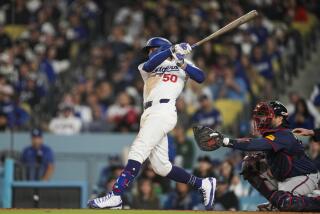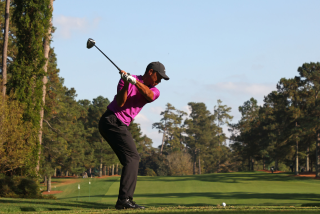‘Golfer’s Spine’ May Be Par for the Course
- Share via
WASHINGTON — Add to tennis elbow and runner’s knee another sports complaint: golfer’s spine.
The powerful twisting motion in some golfers’ swings can, over time, deform bones in the lower back, researchers say. One study terms it the “crunch factor.”
“It looks like what is going on is a combination of how the spine twists and how it bends to the side,” said researcher Scott A. Banks of the Orthopaedic Research Laboratory, Good Samaritan Medical Center, West Palm Beach, Fla.
Banks and other researchers on golf injuries presented their data recently at a meeting of the American Academy of Orthopaedic Surgeons in New Orleans.
Banks’ team studied the swings of 43 healthy, experienced male golfers ages 18 to 84, to see where the stress builds. They taped reflective discs over the golfers’ joints, then used high-speed cameras to record how the discs moved during the swings. The cameras’ data were fed into a computer, which produced a three-dimensional analysis.
Older golfers had the lowest crunch-factor levels, meaning that they had the least torque. Younger golfers had the highest levels, the study found. The greater torque in the young could reflect the natural flexibility of youth, and the older golfers may have gotten stiffer with age, said epidemiologist David A. Morgan, who also worked on the study.
But it could also be because older players learned a swing that had less body movement, Banks said. “In the early part of the century, a swing where the hips and shoulders moved more together was more common,” he said. “There was less twisting of the back.”
The change in swing came because steel shafts replaced hickory shafts in clubs, said Dr. Timothy M. Hosea, who has done separate camera-and-computer research on low back pain in golfers.
Steel shafts allowed greater accuracy, but they were less flexible, said Hosea, of the University of Medicine and Dentistry of New Jersey-Robert Wood Johnson Medical School, New Brunswick, N.J. To get more power behind the hit, he said, golfers began to twist their bodies.
Japanese medical imaging experts say they have seen the apparent results of the repetitive stress on the lower back. They performed X-ray and CT scans of 26 right-handed male elite amateur or professional golfers, and compared them with results from 105 matched non-golfers.
Many members of both groups had discernible low-back problems. But the golfers were more likely to have malformations on their right side, where the torque from the swing would have the greater effect on right-handed people, the Japanese study said. About 60% of golfers did, compared with about 50% of non-golfers.
Back problems afflict golfers and non-golfers, but the right-sided problems were clearly a bigger problem for golfers, Banks said.
About 90% of golfers’ back problems can be treated with physical therapy, said Dr. Pierce E. Scranton Jr. of Seattle, sports medicine chairman of the American Orthopaedic Foot and Ankle Society. Muscle relaxants and anti-inflammatories can control the immediate pains, he said.
In some cases, however, the problem may require surgery to remove a herniated disk or even fused vertebrae, Hosea said.
Golfers can try to prevent trouble by developing a swing that is right for their bodies, Scranton said. “Everyone has their own body’s unique swing,” he said. “I would urge golfers to find their comfort level. There are many ways to do things right.”






